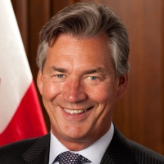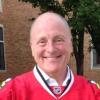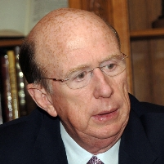Canada
Lay of the Land: Canada occupies most of the northern portion of the North American continent. In the far east of Canada, the Appalachian Mountains extend into the Maritime provinces, creating a hilly, forested landscape with and irregular coastline punctuated by scenic bays and inlets. To the west is a lowlands region stretching from the St. Lawrence River to the Great Lakes. This is a fertile area of dairy farms, tobacco plantations, and orchards. Also located in this region, where 60% of all Canadians live, are the cities of Toronto, Ottawa, Montréal, and Quebec. Further westward are the Canadian prairies, a belt of flatlands running from the Great Lakes to the Rocky Mountains. In this treeless region, wheat fields blanket the land from horizon to horizon. To the north of these regions, the sparsely inhabited frozen Canadian Shield region extends northward from Hudson Bay into the Arctic Circle. Composing one half of Canada's total area, this region is covered by scrub forests, tundra, and swamplands, and includes immense ice- and glacier-coated islands, such as Baffin Island, which is the size of Spain. The Canadian far west is dominated by the Rocky, Coast, and Mackenzie mountains. In the southwestern corner of the nation, there is a relatively warm coastal region, where the cities of Vancouver and Victoria are located.
Early relations between these two North American giants were marked by military encounters before either nation was officially established. During the American Revolution, the colonial army sent forces north into Canadian territory to capture Québec and turn it into the “fourteenth colony,” according to Canadian historians. An American army led by Richard Montgomery captured Montréal, while another led by Benedict Arnold laid siege to a fortress in Québec. During ensuing battles, Montgomery was killed and Arnold wounded, and the Americans eventually retreated and gave up their campaigns in Canada.
The United States and Canada are more intertwined than the United States is with any other nation in the world. The border between Canada and the United States is the longest border in the world. Officially known as the International Boundary, it stretches 5,522 miles (8,891 km) long, including the 1,539 miles (2,477 km) shared by Alaska. Bilateral efforts are made through the Smart Border Declaration, a 30-point action plan that facilitates the legitimate flow of people and goods through this border.
The trade relationship between the United States and Canada is larger than that between any two countries in the world. In 2007, total trade between the two countries exceeded $560 billion. The two-way trade that crosses the Ambassador Bridge between Detroit, Michigan and Windsor, Ontario equals all US exports to Japan. Canada is the leading export market for 36 of the 50 US States and ranked in the top three for another 10 States. In fact, Canada is a larger market for US goods than all 27 countries of the European Community combined, whose population is more than 15 times that of Canada.
In February and September 2003, Canadian officials, including Canadian Security and Intelligence Service (CSIS) agents, interviewed Khadr at Guantánamo and shared that information with US authorities. Khadr’s attorneys have long argued that these interview records are critical to his defense.
The court found that, at the time Canadian officials interviewed Khadr, “the regime providing for the detention and trial of Mr. Khadr …constituted a clear violation of fundamental human rights protected by international law.”
The justices concluded that Canadian officials participated in a process that violated Canada’s international human rights obligations, and that Khadr is entitled to invoke his rights under the Canadian Charter of Rights and Freedoms. As a remedy, the court ordered that Khadr be given access to all records of interviews conducted by Canadian officials with him in 2003 at Guantánamo Bay.
 Doer, Gary
Doer, Gary
A longtime politician and former labor leader, Gary Albert Doer assumed his responsibilities as Canada’s ambassador to the United States on October 19, 2009.
- Table of Contents
- News
- Overview
- Basic Information
- History
- Newspapers
- History of U.S. Relations with Canada
- Current U.S. Relations with Canada
- Where Does the Money Flow
- Controversies
- Human Rights
- Debate
- Past Ambassadors
- Ambassador to the U.S.
- Embassy Web Site in the U.S.
- Comments
- Leave a comment
U.S. Ambassador to Canada

President Barack Obama has nominated Bruce A. Heyman, a partner in the Chicago office of Wall Street investment bank Goldman Sachs, to be the next U.S. ambassador to Canada. The September 19 announcement ended months of speculation that Heyman, whose name first surfaced in April, had lost interest in the job, been disqualified by his investments, or had been derailed by pipeline politics. Instead, Heyman completed diplomatic “charm school” this summer, and if confirmed by the Senate would succeed fellow bundler David Jacobson, who departed Ottawa at the end of his four-year term in July, leaving the embassy under the care of Chargé d’Affaires Richard Sanders.
Although Heyman has been working with wealthy Canadian clients of Goldman since 2001, his qualifications for nomination were not damaged by the fact that he has been a “mega-bundler” for both of Obama’s presidential runs, helping to raise millions of dollars and serving on Obama’s National Finance Committee in 2012. A longtime Democrat in an industry dominated by Republicans, Heyman has donated more than $180,000 to political causes, most of it to Democratic candidates and organizations, including $96,000 to the Democratic National Committee. He has also donated more than $36,000 to the Goldman Sachs PAC.
Heyman will need to study up for his nomination hearing, because he will almost certainly face questions from Republican senators over the controversial proposal to build the Keystone XL pipeline, which would carry tar sands crude oil from Alberta to the Gulf Coast for refining and export. Republicans claim that the pipeline would create jobs, but environmentalists argue that tar sands oil is too heavy in carbon to be used in a rapidly warming planet. The administration is expected to make a decision on whether to allow construction of a 1,179-mile section of the proposed pipeline from Alberta to Nebraska soon.
Born circa 1958, Heyman grew up in Dayton, Ohio, where he shoveled snow and mowed lawns as a boy. He earned a B.A. in Business Administration at Vanderbilt University in 1979 and an MBA there in 1980. During his high school years, Heyman worked as a part-time salesman at Rike's Department Store in Kettering, Ohio, and General Surplus in Dayton, and, as a college student, as a sandwich-maker at Sub Station in Nashville. In the summer of 1979, he worked as a summer researcher for the antitrust and restraint of trade subcommittee of the House of Representatives.
In 1980, Heyman began his long association with the investment banking firm of Goldman Sachs, working as an associate from 1980 to 1985, and as a vice president from 1985 to 1999. As a VP, Heyman also worked as associate regional manager of Goldman’s Chicago private client group from 1997 to 1999. From 1999 to 2000, he was co-head of recruiting for Goldman’s newly created investment management division, leaving that job in 2001 to become regional manager of the Midwest private wealth management group, which covers 13 states and half of Canada. In 2004, he was made a partner of Goldman Sachs, where he still worked when nominated for the ambassadorship.
Bruce Heyman and his wife, Vicki Heyman, live in Chicago. Their son, David, works for JPMorgan Chase.
-Matt Bewig
To Learn More:
Goldman Sachs Partner Learned Value of 'Overcommunication' (by Ann Therese Palmer, Chicago Tribune)
Chicago Investment Banker Bruce Heyman will be next U.S. Ambassador to Canada (Canadian Press)
Bruce Heyman Named U.S. Ambassador to Canada (by Susana Mas, CBC News)
morePrevious U.S. Ambassador to Canada

Lay of the Land: Canada occupies most of the northern portion of the North American continent. In the far east of Canada, the Appalachian Mountains extend into the Maritime provinces, creating a hilly, forested landscape with and irregular coastline punctuated by scenic bays and inlets. To the west is a lowlands region stretching from the St. Lawrence River to the Great Lakes. This is a fertile area of dairy farms, tobacco plantations, and orchards. Also located in this region, where 60% of all Canadians live, are the cities of Toronto, Ottawa, Montréal, and Quebec. Further westward are the Canadian prairies, a belt of flatlands running from the Great Lakes to the Rocky Mountains. In this treeless region, wheat fields blanket the land from horizon to horizon. To the north of these regions, the sparsely inhabited frozen Canadian Shield region extends northward from Hudson Bay into the Arctic Circle. Composing one half of Canada's total area, this region is covered by scrub forests, tundra, and swamplands, and includes immense ice- and glacier-coated islands, such as Baffin Island, which is the size of Spain. The Canadian far west is dominated by the Rocky, Coast, and Mackenzie mountains. In the southwestern corner of the nation, there is a relatively warm coastal region, where the cities of Vancouver and Victoria are located.
Early relations between these two North American giants were marked by military encounters before either nation was officially established. During the American Revolution, the colonial army sent forces north into Canadian territory to capture Québec and turn it into the “fourteenth colony,” according to Canadian historians. An American army led by Richard Montgomery captured Montréal, while another led by Benedict Arnold laid siege to a fortress in Québec. During ensuing battles, Montgomery was killed and Arnold wounded, and the Americans eventually retreated and gave up their campaigns in Canada.
The United States and Canada are more intertwined than the United States is with any other nation in the world. The border between Canada and the United States is the longest border in the world. Officially known as the International Boundary, it stretches 5,522 miles (8,891 km) long, including the 1,539 miles (2,477 km) shared by Alaska. Bilateral efforts are made through the Smart Border Declaration, a 30-point action plan that facilitates the legitimate flow of people and goods through this border.
The trade relationship between the United States and Canada is larger than that between any two countries in the world. In 2007, total trade between the two countries exceeded $560 billion. The two-way trade that crosses the Ambassador Bridge between Detroit, Michigan and Windsor, Ontario equals all US exports to Japan. Canada is the leading export market for 36 of the 50 US States and ranked in the top three for another 10 States. In fact, Canada is a larger market for US goods than all 27 countries of the European Community combined, whose population is more than 15 times that of Canada.
In February and September 2003, Canadian officials, including Canadian Security and Intelligence Service (CSIS) agents, interviewed Khadr at Guantánamo and shared that information with US authorities. Khadr’s attorneys have long argued that these interview records are critical to his defense.
The court found that, at the time Canadian officials interviewed Khadr, “the regime providing for the detention and trial of Mr. Khadr …constituted a clear violation of fundamental human rights protected by international law.”
The justices concluded that Canadian officials participated in a process that violated Canada’s international human rights obligations, and that Khadr is entitled to invoke his rights under the Canadian Charter of Rights and Freedoms. As a remedy, the court ordered that Khadr be given access to all records of interviews conducted by Canadian officials with him in 2003 at Guantánamo Bay.
 Doer, Gary
Doer, Gary
A longtime politician and former labor leader, Gary Albert Doer assumed his responsibilities as Canada’s ambassador to the United States on October 19, 2009.
Comments
U.S. Ambassador to Canada

President Barack Obama has nominated Bruce A. Heyman, a partner in the Chicago office of Wall Street investment bank Goldman Sachs, to be the next U.S. ambassador to Canada. The September 19 announcement ended months of speculation that Heyman, whose name first surfaced in April, had lost interest in the job, been disqualified by his investments, or had been derailed by pipeline politics. Instead, Heyman completed diplomatic “charm school” this summer, and if confirmed by the Senate would succeed fellow bundler David Jacobson, who departed Ottawa at the end of his four-year term in July, leaving the embassy under the care of Chargé d’Affaires Richard Sanders.
Although Heyman has been working with wealthy Canadian clients of Goldman since 2001, his qualifications for nomination were not damaged by the fact that he has been a “mega-bundler” for both of Obama’s presidential runs, helping to raise millions of dollars and serving on Obama’s National Finance Committee in 2012. A longtime Democrat in an industry dominated by Republicans, Heyman has donated more than $180,000 to political causes, most of it to Democratic candidates and organizations, including $96,000 to the Democratic National Committee. He has also donated more than $36,000 to the Goldman Sachs PAC.
Heyman will need to study up for his nomination hearing, because he will almost certainly face questions from Republican senators over the controversial proposal to build the Keystone XL pipeline, which would carry tar sands crude oil from Alberta to the Gulf Coast for refining and export. Republicans claim that the pipeline would create jobs, but environmentalists argue that tar sands oil is too heavy in carbon to be used in a rapidly warming planet. The administration is expected to make a decision on whether to allow construction of a 1,179-mile section of the proposed pipeline from Alberta to Nebraska soon.
Born circa 1958, Heyman grew up in Dayton, Ohio, where he shoveled snow and mowed lawns as a boy. He earned a B.A. in Business Administration at Vanderbilt University in 1979 and an MBA there in 1980. During his high school years, Heyman worked as a part-time salesman at Rike's Department Store in Kettering, Ohio, and General Surplus in Dayton, and, as a college student, as a sandwich-maker at Sub Station in Nashville. In the summer of 1979, he worked as a summer researcher for the antitrust and restraint of trade subcommittee of the House of Representatives.
In 1980, Heyman began his long association with the investment banking firm of Goldman Sachs, working as an associate from 1980 to 1985, and as a vice president from 1985 to 1999. As a VP, Heyman also worked as associate regional manager of Goldman’s Chicago private client group from 1997 to 1999. From 1999 to 2000, he was co-head of recruiting for Goldman’s newly created investment management division, leaving that job in 2001 to become regional manager of the Midwest private wealth management group, which covers 13 states and half of Canada. In 2004, he was made a partner of Goldman Sachs, where he still worked when nominated for the ambassadorship.
Bruce Heyman and his wife, Vicki Heyman, live in Chicago. Their son, David, works for JPMorgan Chase.
-Matt Bewig
To Learn More:
Goldman Sachs Partner Learned Value of 'Overcommunication' (by Ann Therese Palmer, Chicago Tribune)
Chicago Investment Banker Bruce Heyman will be next U.S. Ambassador to Canada (Canadian Press)
Bruce Heyman Named U.S. Ambassador to Canada (by Susana Mas, CBC News)
morePrevious U.S. Ambassador to Canada








Comments